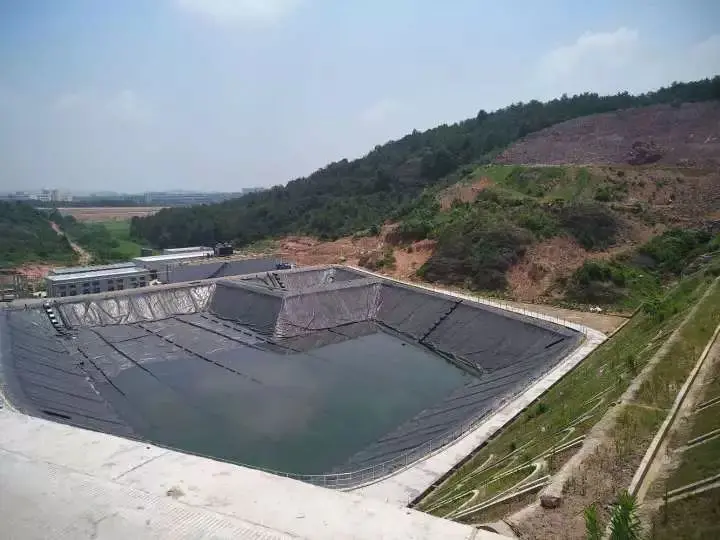Depending on engineering requirements and material compatibility, the connection of geomembrane can be achieved by various methods. The most common methods are hot melt welding and glue bonding.
158847.webp)
Hot Wedge Welding:
Hot wedge welding is a widely used method for connecting geomembranes, particularly in applications where durability and watertight seals are crucial. The process involves heating the edges of the geomembranes using a hot wedge welding machine, then pressing them together to create a strong bond.
Advantages:
Durability: Hot wedge welding creates a durable and reliable connection between geomembranes, capable of withstanding harsh environmental conditions, such as temperature variations and chemical exposure.
Watertight Seals: The resulting welds are typically watertight, providing effective containment for liquid or gas substances.
Longevity: Properly welded geomembrane seams can last for decades, ensuring the longevity of containment structures such as landfills, ponds, and reservoirs.
High Strength: Hot wedge welding produces welds with high tensile strength, capable of resisting stress and deformation over time.
Versatility: This method is compatible with various geomembrane materials and thicknesses, offering versatility in different project applications.
Disadvantages:
Equipment Cost: Hot wedge welding requires specialized equipment, which can be costly to purchase and maintain. Additionally, operators need training and expertise to ensure proper welding techniques.
Surface Preparation: Effective welding requires clean and dry geomembrane surfaces, necessitating careful surface preparation to achieve optimal results.

Adhesive Bonding:
Adhesive bonding involves applying adhesive to the edges of geomembranes and then pressing them together to form a bond. This method is an alternative to welding and is often used when welding is impractical or when a more flexible connection is desired.
Advantages:
Cost-Effectiveness: Adhesive bonding typically requires less initial investment in equipment compared to hot wedge welding, making it a cost-effective option for certain applications.
Flexibility: Adhesive bonding can accommodate irregular surfaces and provide a more flexible connection compared to welding, which may be advantageous in some situations.
Ease of Use: Adhesive bonding is relatively straightforward and does not require specialized equipment or extensive training, making it accessible to a wider range of users.
Disadvantages:
Adhesive Selection: Choosing the right adhesive is critical for achieving strong and durable bonds. Compatibility between the adhesive and geomembrane material must be ensured, and proper surface preparation is essential for adhesion.
Environmental Considerations: Adhesive bonds may be susceptible to degradation over time, especially in harsh environmental conditions such as UV exposure, temperature fluctuations, and chemical exposure.
Longevity: While adhesive bonds can provide effective sealing in the short term, their long-term durability may be inferior to welded seams, potentially leading to premature failure and leakage.
In conclusion, both hot wedge welding and adhesive bonding are viable methods for connecting geomembranes, each with its own advantages and limitations. The choice between the two depends on factors such as project requirements, budget constraints, and environmental considerations. Hot wedge welding offers superior durability and strength, making it ideal for critical containment applications, while adhesive bonding provides a cost-effective and flexible alternative suitable for certain situations.
No. | Item | Unit | Index | ||||||||
1 | Thickness | mm | 0.30 | 0.50 | 0.75 | 1.00 | 1.25 | 1.50 | 2.00 | 2.50 | 3.00 |
2 | Density | g/cm3 | ≧0.940 | ||||||||
3 | Tensile yield strength | N/mm | ≧4 | ≧7 | ≧10 | ≧13 | ≧16 | ≧20 | ≧26 | ≧33 | ≧40 |
4 | Tensile breaking strength | N/mm | ≧6 | ≧10 | ≧15 | ≧20 | ≧25 | ≧30 | ≧40 | ≧50 | ≧60 |
5 | Yield elongation | % | - | - | - | ≧11 | |||||
6 | Break Elongation | % | ≧600 | ||||||||
7 | Right-angle Tearing strength | N | ≧34 | ≧56 | ≧84 | ≧115 | ≧140 | ≧170 | ≧225 | ≧280 | ≧340 |
8 | Puncture strength | N | ≧72 | ≧120 | ≧180 | ≧240 | ≧300 | ≧360 | ≧480 | ≧600 | ≧720 |
9 | Carbon black content | % | 2.0~3.0 | ||||||||
10 | Dispersion of carbon black | - | There is not more than one level 3 in 10 data, and level 4 and level 5 are not allowed to exist. | ||||||||
11 | Oxidation induction time | min | ≧60 | ||||||||
12 | Low temperature impact embrittlement properties | - | Pass | ||||||||
13 | Water vapor permeability coefficient | g.cm/ (cm2.s.Pa) | ≦1.0*10-13 | ||||||||
14 | Dimensional stability | % | ±2.0
| ||||||||
Note | Technical performance indicators for thickness specifications not listed in the table are required to be performed by interpolation. | ||||||||||
About Haoyang Environmental
At Haoyang Environmental, we specialize in the manufacturing of high-quality geomembrane liners using both hot melt welding and glue bonding techniques. With years of expertise and dedication to excellence, we offer a comprehensive range of geomembrane solutions tailored to meet the diverse needs of our clients.
Our state-of-the-art facilities and advanced manufacturing processes ensure the production of geomembrane liners that adhere to the highest industry standards. Whether you require geomembrane liners for landfill containment, pond lining, or industrial applications, we have the expertise and capabilities to deliver reliable and durable solutions.
As a trusted industry leader, we prioritize quality, innovation, and customer satisfaction in everything we do. Our experienced team of professionals is committed to providing personalized service, technical support, and timely delivery to ensure the success of your projects.
Choose Haoyang Environmental as your partner for premium hot melt welding and glue bonding geomembrane solutions. Experience the difference quality and reliability make in your geomembrane applications.
781.webp)
439.webp)
900.webp)
255.webp)
175.webp)
503.webp)
759.webp)
897.webp)
942.webp)
237.webp)